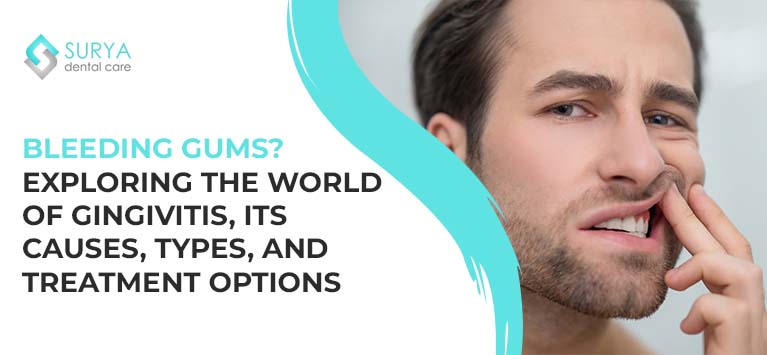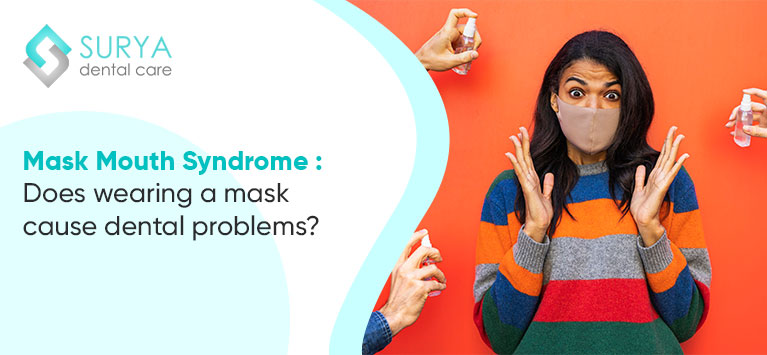Gingivitis usually represents the onset form of periodontal disease, a disorder that involves the parts around the tooth (called the “periodontium”). In its initial stages, this pathology is absolutely reversible and, if treated promptly and competently, bleeding stops and heals without leaving a trace.
On the contrary, when it is neglected, it shows a tendency to become chronic, evolving into periodontitis. In these cases, the gum tends to withdraw, leaving a large part of the tooth uncovered and forming periodontal pockets, potential sites of plaque, which can evolve into tartar.
If it is not removed, tartar constitutes the ideal habitat for bacteria, which tend to multiply by distributing themselves around the tooth and triggering swelling and gum irritation. While healthy gums are characterized by pink colour and a hard and compact consistency, diseased ones show an irregular structure, tend to bleed easily, and are swollen and soft.
What are the causes of gingivitis?
- Two types of factors produce gingivitis: on the one hand, the presence of bacteria that grow by resting on the dental plaque, and on the other, traumatic injuries caused by overly aggressive brushing or using unsuitable toothbrushes.
- Infecting microorganisms found at the contact site between the tooth and the gum have a definite proclivity to multiply, penetrating more and more consistently at the gingival tissue level.
- Pathogens do not meet impediments and quickly reach the more vulnerable regions if the gums are not in excellent condition.
- In the aetiology of this disorder, there are also predisposing causes, including smoking, one of the main risk factors deriving from its toxic substances.
- Diabetes is a metabolic and frequently chronic disease that changes the histological composition of tissues, including the gums, rendering them more susceptible to inflammatory processes.
- Strong hormonal swings, such as those seen during puberty, menopause, pregnancy, and nursing, have a role in the disease’s origin, especially when combined with poor dental hygiene.
- All illnesses that impair the immune system are considered risk factors because they promote bacterial development in the gums.
- The predisposition also plays a very important role since, although not genetically transmissible, a certain familiarity characterizes the disorder.
- In fact, several medicines (such as hypotensives, cortisone, hormonal treatments, antiepileptics, and antidepressants) have been shown to increase the volume of the gums in susceptible people.
- Inadequate dental care can sometimes be the cause of gingivitis.
- Prolonged stress is also seen as a significant cause since it is connected to a decline in immunological defences, which is usually a significant predisposing factor.
Types of gingivitis
Gingivitis can be acute or chronic in nature. In the first instance, significant symptoms appear. Chronic types are distinguished by hazy symptoms and little or no pain. Periodic minor bleeding of the gums when brushing may occur, as well as halitosis. It is critical to recognize that slow gingivitis is characterized by recurrent exacerbations.
Gum inflammation is categorized not only by its shape but also by the type of its progression.
Catarrhal gingivitis
Reddening of the gum region is a sign of catarrhal gingivitis. Mechanical activity may cause itching and bleeding, as well as slight pain. This is the most common and simplest to cure kind of inflammation. It is frequently the first stage in the formation of other kinds.
Ulcerative gingivitis
Ulcerative necrotic gingivitis is characterized by the development of open ulcers, the death of areas of gum tissue, and a strong bad breath. The emergence of a grey plaque is one of the common signs. The condition is more difficult to cure; without prompt treatment, purulent foci and severe necrosis may develop.
Hypertrophic and atrophic gingivitis
Necrotic ulcer is followed by hypertrophic gingivitis – there is excessive growth of tissues that cover the crowns of the teeth. There is keratinization of the gums. The atrophic form of the disease, on the contrary, is characterized by a decrease in the level of the gums exposure of the necks of the teeth. This condition is dangerous due to the loss of healthy teeth.
Desquamative gingivitis
This type of inflammation is characterized by abundant desquamation of the gingival epithelium. Distinctive features are pronounced redness and noticeable peeling areas on the surface of the mucous membranes.
Gingivitis treatments
- The essential prerequisite for preventing or treating gingivitis is correct home dental hygiene, which involves the use of a toothbrush suitable for your teeth, adequate toothpaste, and dental floss.
- It is also necessary to periodically carry out professional teeth cleaning at a dental office, consisting of the removal of plaque or tartar, to eliminate any risk factor.
- If cariogenic processes or other dental disorders are present, it is necessary to intervene promptly to prevent the gums from becoming involved and developing inflammation.
- When possible, it would be useful to limit smoking and the consumption of drugs that predispose to this disorder, as well as brushing your teeth after contact with sweet substances that tend to facilitate bacterial multiplication.
- An effective treatment (and prevention) of gingivitis cannot be separated from a correct nutritional regime since it is well-known that food deficiencies cause potentially very harmful metabolic disorders.
- Deficient states of vitamins (avitaminosis) and calcium (a very important mineral for the well-being of the teeth and oral cavity) represent two risk factors of considerable importance.
- Utilizing “do-it-yourself” ways to cure gingivitis is never suggested because many of the items available for treatment (such as mouthwashes or sprays) are ineffective and may even aggravate the symptoms.
- In more extreme situations and always under medical supervision, anti-inflammatory and bactericidal pharmacological medicines for topical application and antiseptics with disinfection activity, such as chlorhexidine, might be used.
- Mallow, chamomile, aloe vera, witch hazel, and sage are phytotherapeutic medicines based on calming ingredients. Propolis is a natural preparation with strong antibacterial properties that may be employed in various formulations.
- Excellent outcomes are generally obtained by adopting vitamin and mineral intake and carefully monitoring the eating program.
Conclusion
While understanding gingivitis is crucial, it’s vital to remember that managing it requires professional guidance. Dental experts can accurately diagnose the type and severity of your condition, ensuring appropriate treatment and preventive measures. Maintain good oral hygiene, follow a balanced diet rich in essential nutrients, and don’t hesitate to seek professional dental care for regular check-ups and cleanings. Gingivitis can be reversible if addressed early, so trust the expertise of dental professionals to safeguard your oral health.








